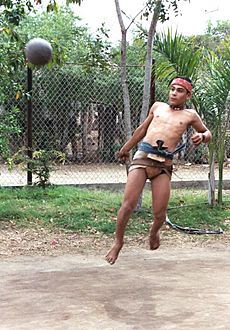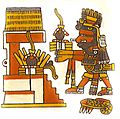Mesoamerican ball game facts for kids
The Mesoamerican ball game is a sport that people in Mesoamerica have played since about 1,400 B.C.E. It was the first team sport in history, as far as historians know.
The Olmecs, who lived from 1,200 B.C.E. to 400 B.C.E., played the Mesoamerican ballgame. They may have created the game. The ancient Mayans played the game; they called it pitz in Classical Maya. Later, the Aztecs played it; in their language, Nahuatl, they called the game ōllamaliztli.
In some parts of Mexico, indigenous people still play a more modern version of the game, called ulama. This means that people have played the Mesoamerican ballgame for over 3,400 years – longer than any other sport in history. The Mesoamerican ballgame was also the first sport in history ever to use a rubber ball.
Rules
The game's goal was to shoot a ball through a stone hoop about 35 inches (89 centimetres) wide. The ball, called an ulli, was made out of rubber. It weighed about 9 pounds (4.1 kilograms), about as much as a brick. The court, called a tlachtili, was around 100 to 200 feet (30 to 61 metres) long. It had a wall on each side. The stone hoops hung on these walls.
The court was usually in the shape of an “I,” although the shape was sometimes different. A line ran down the center of the court. From that line, the floor sloped to meet the walls.
The players were only allowed to use their heads, elbows, legs, and hips to hit the ball. The ball was not allowed to touch the ground, so the players often dove to avoid losing points. If one of the teams got the ball through the stone hoop, the game was over and that team won. However, this was very hard to do, since the stone hoops could be as high as 20 feet (6.1 metres) off the ground. Since getting the ball through the hoop was uncommon, a team could also score points by hitting one of six markers alongside the edges of the court.
Religious importance
The Mesoamerican ballgame also held a very important religious meaning. In Aztec culture, for example, the game was meant to represent the combat that happened every day on the "ball court" in the underworld, where the sun fought with the night to get across.p.173
Modern version
In modern times, the Aztec ballgame changed into ulama. People still play this game in a few communities in the Mexican state of Sinaloa.
Ulama uses temporary courts, made by drawing thick lines in the dirt. There are three different ways to play ulama. In the different versions of the game, players may use their hips, forearms, or paddles to hit the ball.
Images for kids
-
View into the ballcourt at Chichen Itza
-
The yoke and kneepads identify this molded ceramic Maya figurine as a ballplayer. Like many of these Jaina Island style figurines, it also functions as a whistle. 600–900 CE.
-
National Museum of Anthropology in Mexico City – a figure of a pelota player
-
A solid rubber ball used or similar to those used in the Mesoamerican ballgame, from Kaminaljuyu, 300 BC to 250 AD, with a manopla, or handstone, used to strike the ball.
-
Ballcourt at Tikal, in the Petén Basin region of the Maya lowlands
-
10px]]-shape ball court in Cihuatan site, El Salvador
-
Ruins at Wupatki National Monument, Arizona. There is disagreement among archaeologists whether these structures in the American Southwest were used for ballgames, although the consensus appears that they were. There is further discussion concerning the extent that any Southwest ballgame is related to the Mesoamerican ballgame.
-
Stela from El Baúl in the Cotzumalhuapa Nuclear Zone, showing two ballplayers.
-
In this detail from the late 15th century Codex Borgia, the Aztec god Xiuhtecuhtli brings a rubber ball offering to a temple. The balls each hold a quetzal feather, part of the offering.
-
Ballcourt marker, from the Maya site of Chinkultic, dated to 591. The ball itself displays the finely incised portrait of a young deity.
-
Great Ballcourt at Chichen Itza
-
Ballplayer painting from the Tepantitla, Teotihuacan murals. Note the speech scroll issuing from the player's mouth.
See also
 In Spanish: Juego de pelota mesoamericano para niños
In Spanish: Juego de pelota mesoamericano para niños























